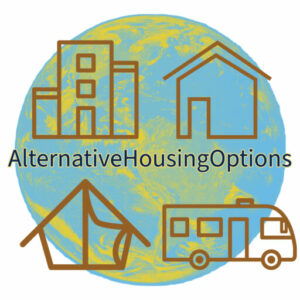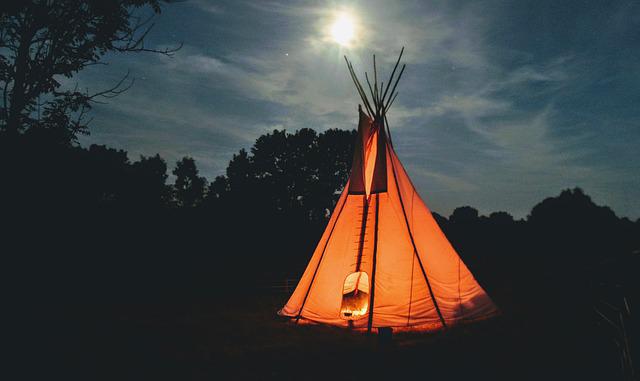When the weather gets warmer, I think about camping. One of the more interesting ways of camping is to build a tipi or tepee, a home for most of the plains Indian tribes in North America due to the readily available materials like logs and bison hides.
Modern-day tepees are often customized for each owner. They are shaped like a cone and built specifically for portability, and are sized for a number of people sleeping inside. Today’s fabrics are lightweight, weather-resistant, and have UV protection. Some tipis can be made with a metal crown instead of lashing the poles together in the center. With a Tipi, you can be a modern-day nomad and camp permanently anywhere you can legally place a tent.
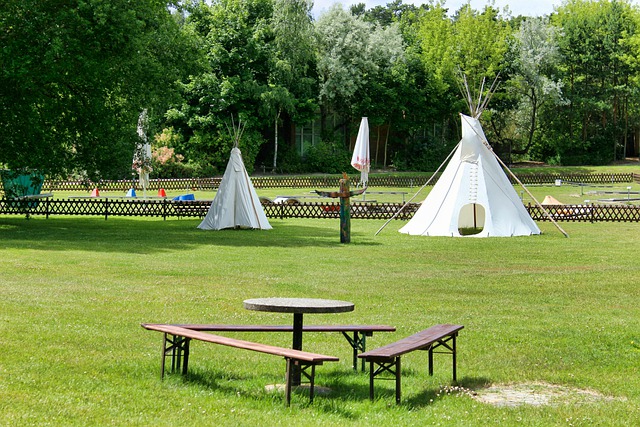
What goes into building a tipi or tepee?
The tipi structure is several straight wooden poles tied in a conical shape with a spread-out base. A wrap, made up of canvas, hide, tarps, or even birch bark, is lifted along with the last pole (called the Lift Pole) and laced together around the front.
Stakes can keep the wrap tight, or you can roll up the walls to let lots of air flow. Moving the fire slightly forward from the center will obtain more living space inside. The smoke hole will then be right above the fire, and you won’t need it open all of the time. An ozan is an extra six-foot-tall tipi liner hung around the conical home’s entire interior. The ozan keeps the rain from coming inside the living area.
Fourteen to sixteen feet is a good general-purpose size for a couple of people. An eighteen or nineteen-foot tipi will fit four or five people. They take a couple of hours to put up. A bigger tepee, up to 25 or 30 feet, is usually used as a communal space in a tipi village. Most tepee canvases are pure cotton canvas and treated with a rot and waterproofing compound.

Pros of living in a tipi
- Temperature control- You’ll need to open the smoke flaps in hot weather and lift part of the wrap to catch any moving air.
- Very comfortable- Due to the accurate placement of side, door opening, and smoke flaps, the contemporary tepee is very comfortable. Special cold weather fabrics allow you to weather frigid climates.
- Indoor fire pit- Tipis are designed to use a fire pit or stove indoors that burns dry wood. When you use the wood fire, the smoke exits through the smoke flaps at the tipi’s top while fresh air is drawn in through ground-level side flaps.
- One with nature- Living in a tipi allows you to become one with the surrounding environment. You’ll hear all of the nature sounds outside your door.
- No alarm clock necessary- Tepee materials let in natural light, so you’ll wake with the sun. You’ll probably also sleep better in the dark if you don’t keep lamps running.
- Storage and space simultaneously- Tepee interiors can accommodate storage containers, shelves, and trunks, yet the space will feel large due to the height.
- Cost-effective- A tepee costs about 20% less than a yurt when considering a natural fabric structure.
Cons of living in a tipi
- Need good liner for winter- Tipis are not great at holding in heat. It would help if you had an extra liner. Their cone shape, paired with the way they are pitched, and the smoke hole at the top, create a natural draft, sucking in air from below and forcing it out the top. This makes it very cold in the winter without a ground liner.
- Nature invades- Tipi doors and edges have holes where small animals and critters can crawl inside, such as bugs, mosquitoes, and lizards. You can add a mosquito net to your canvas.
- Improperly sized ozan- Be sure your ozan overlaps or water may get into your living area. Make sure you set up the ozan correctly.
- Dirty- Mud and dirt will get inside the main living area if you don’t prepare for an entrance to take your shoes off. You may need an extra tarp if the floor is wet or sandy.
How to make a tipi a permanent home
There are a few changes to the tipi design that you’ll want to consider if you plan on permanently camping in a tipi. A platform, wood-burning stove, an ozan, and special flame resistant tipi coverings are a few you’ll want to buy for a more comfortable home.
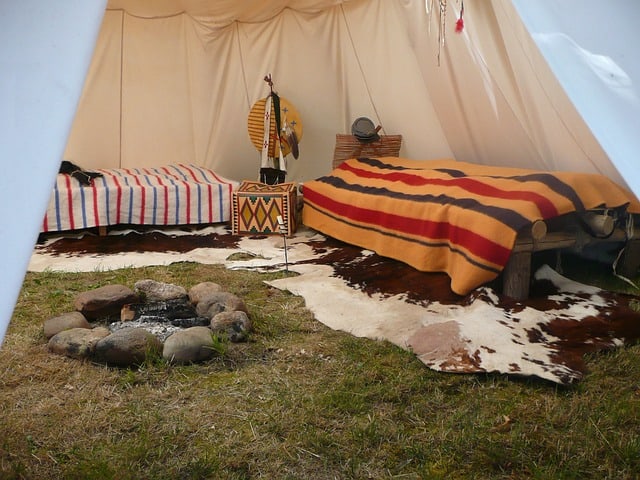
Platform
If you’re considering using the tipi as a permanent home, you may want to put your tipi on a raised wooden platform. It is best if the platform extends at least 2 feet beyond the diameter of the tipi. Yurts are often built this way.
Wood-burning stove
Tepees were initially designed for a ground-level open fire near the center of the tipi floor. This fire provided for heating and cooking. A wood stove or heater with an insulated smoke stack will make life easier and more comfortable for permanent camping.
You can help control the temperature with the smoke flaps and ground-level openings. A woodstove will keep the interior much hotter than a ground-level fire. Keeping the smokestack 3-4 feet above the woodstove will help eliminate smoke. If not appropriately insulated, a smokestack can dry out your tipi canvas and potentially cause a fire.
Ozan and flame resistant coverings
The ozan is an interior cloth or rain cover that forms a canopy over the back third of the tepee behind the fire. It keeps rain, snow, and moisture away from the main living area. It can also help to hold in heat. The ozan drops behind the main liner and will divert water away from your tipi. If you’re using a wood stove, you may also want to invest in a flame-resistant covering to hold up to higher temperatures.
Cost of living in a tipi
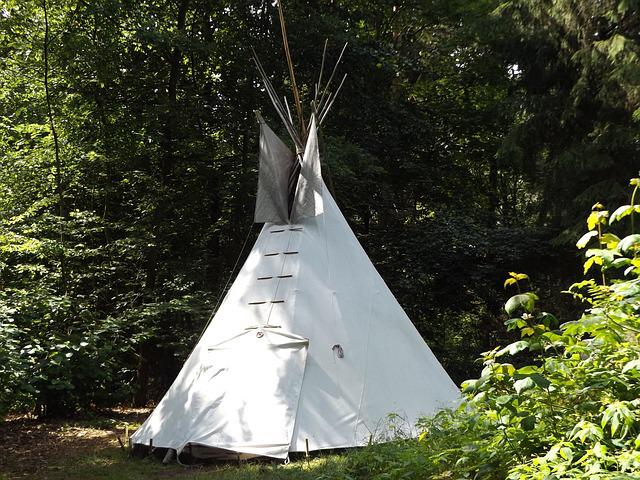
A tipi is cheaper than a yurt when looking at them as a permanent home. A basic, 14-foot, authentic tipi will cost you $2647 for the package with liner and flame resistant cover (add in another $400 for poles). Costs can increase about $500-700 as the size increases. However, for $3000, you can have a tipi for a couple of people to live.
The DIY cost of a tipi can be much less. On OutdoorRevival.com, a video talks about building a DIY tepee and what you would need to make it functional and comfortable. The tarp was $25 and about $50-100 in supplies.
Try before you buy
You can find a tipi available for rent in a KOA campground. By checking them out, you’ll know if you’re willing to invest the money to customize a tipi for camping or permanent living.
Frequently asked questions about tipis or tepees

How do you store a tipi?
To store your poles, lay them flat and off the ground. Takedown the tipi cover, make sure it’s completely dry, and fold it neatly. Store in a moisture-free, rodent-free plastic container.
Will the tipi stand up to strong winds?
The design of the tipi and correctly pitching it is usually enough to make sure the tipi stands strong against the wind. If you are putting your tipi up where the wind is strong, make sure the door is downwind. You can always stake down the poles with extra rope and steel stakes.
Can I have a fire pit in the tipi?
Yes, of course. A fire pit should be located just forward from the center of the tipi, so it is under the smoke opening. Smoke flaps will help you keep your tipi clear of smoke.
How long does it take to put up a tipi?
It will take longer the first time you put it up. Estimate 1/2 day to a day with a few friends the first time. You’ll be able to do it in a couple of hours after some practice.
Are you considering a tipi for permanent camping?
A tipi can be an authentic way to experience the outdoors and alternative housing. Be sure to find a camping area or boondocking area where you’ll be able to set up a deck if you want one for a base off the ground. Follow all of your safety instructions for setting up your tipi and stove. Check out our article about camping as an alternative housing option.
